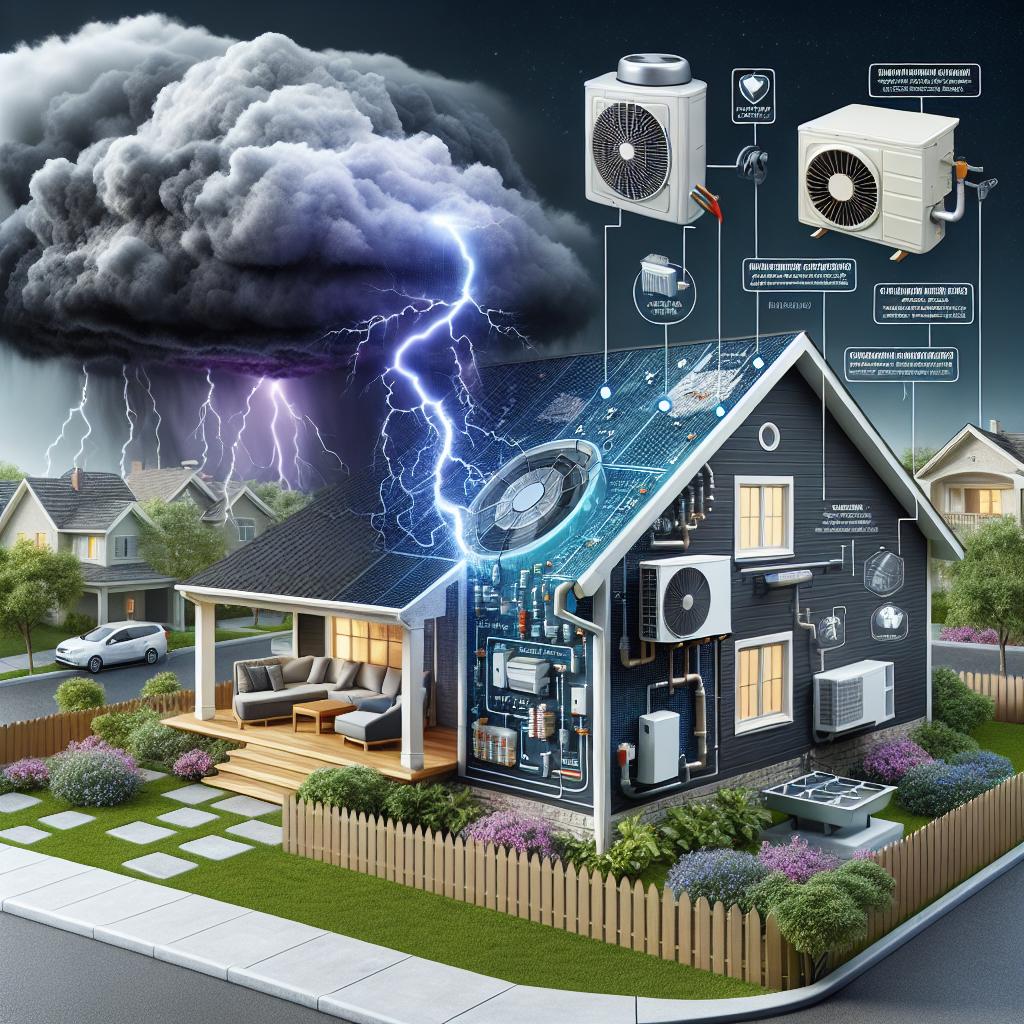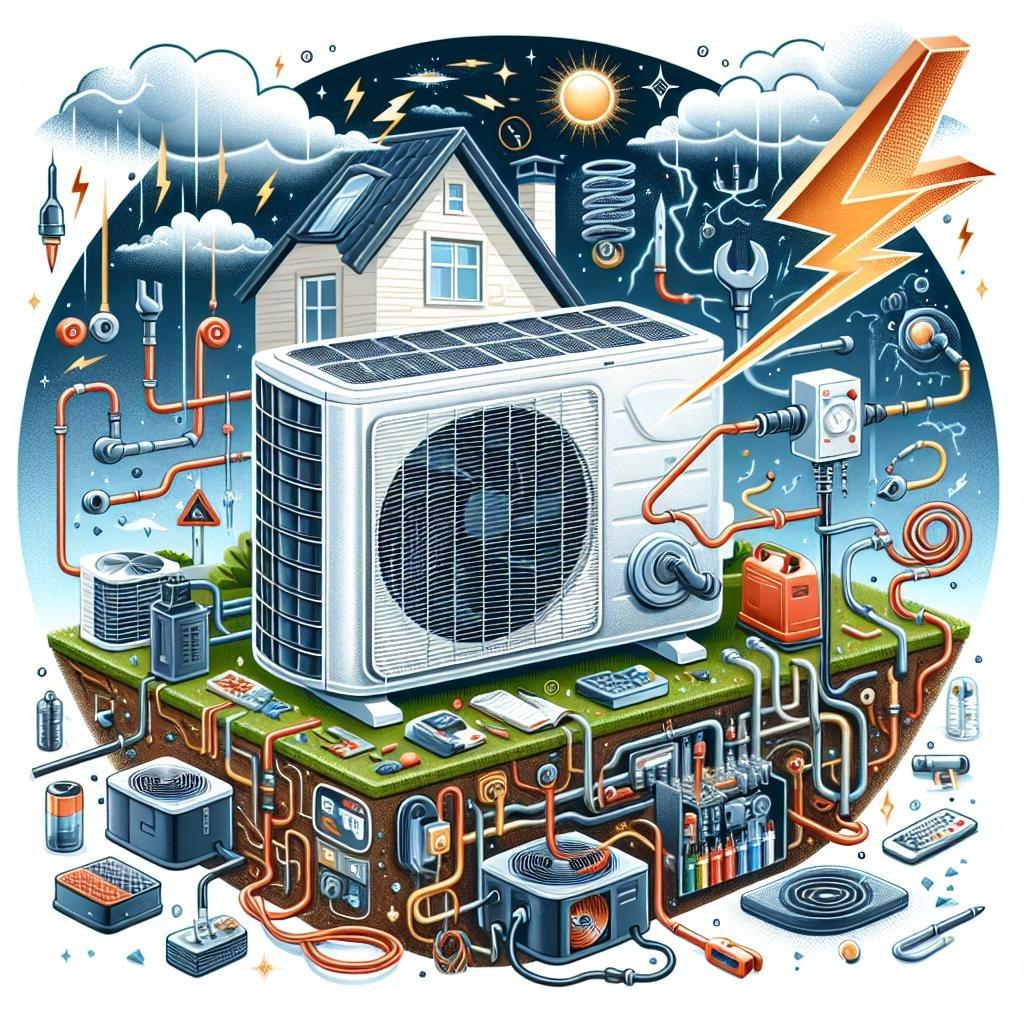As the summer heat rises and the demand for comfort becomes paramount, mini split air conditioning systems have surged in popularity, offering an efficient way to cool your living spaces without the bulk of traditional units. However, with their growing presence comes the need for proper protection, particularly in storm-prone areas where lightning strikes can pose a significant threat. Just as homeowners fortify their spaces against the elements, safeguarding your mini split AC system from electrical surges caused by lightning is an essential yet often overlooked task. In this article, we will explore the best practices for properly grounding and protecting your mini split AC system, ensuring that it remains a reliable source of refuge on even the hottest days, while standing resilient against nature’s tempestuous might. Join us as we delve into practical tips, essential tools, and preventative measures to help you secure your cooling investment for years to come.
Understanding the Risks of Lightning Strikes on Mini Split AC Systems
Lightning strikes pose a significant threat to mini split AC systems, primarily due to their exposed outdoor units. When a storm brews, the electrical energy from a lightning strike can travel through the air and directly affect the AC system, leading to potential damage. The risk is particularly high in areas prone to thunderstorms. Keeping this in mind, it’s crucial to recognize the vulnerabilities of these systems. Here are some key risks to be aware of:
- Direct Strike: A direct hit can result in immediate and catastrophic failure.
- Surges: Lightning can cause power surges that may damage the internal components.
- Grounding Issues: Improper grounding can amplify the effects of a nearby strike.
- Electrical Fire: The intense energy has the potential to ignite fires within home electrical systems.
To mitigate these risks, ensuring proper grounding and protection for your mini split AC system is essential. Grounding the unit allows excess electrical currents to safely dissipate into the earth, significantly reducing the likelihood of damage. Below is a simple table outlining essential grounding measures:
| Grounding Measure | Description |
|---|---|
| Ground Rod Installation | Drive a copper ground rod into the earth near the AC unit. |
| Wire Connection | Use heavy-duty ground wire to connect the AC’s grounding terminal to the ground rod. |
| Surge Protector | Install a surge protector designed for HVAC systems to absorb excess voltage. |

Essential Grounding Techniques for Enhanced Safety and Performance
Grounding your mini split AC system is an essential step in safeguarding it against lightning strikes. Proper grounding minimizes the risk of electrical surges caused by lightning, which can lead to malfunctions or complete system failures. To effectively ground your unit, ensure that you utilize a dedicated grounding rod at least 8 feet long, driven at least 4 feet into the ground. Connect a high-quality copper wire, preferably 10 or 12 AWG, from the rod to the air conditioner’s grounding terminal. Additionally, consider installing a surge protector specifically designed for HVAC systems to offer an extra layer of protection.
Regular maintenance is key to enhancing the longevity and performance of your system. Inspect the grounding connections periodically to ensure they remain secure and corrosion-free. It’s also advisable to keep vegetation around the grounding rod trimmed to prevent interference with its performance. Here’s a brief checklist to follow:
- Check grounding connections for tightness and corrosion.
- Inspect surge protectors for functionality.
- Maintain clear vegetation around the grounding area.

Implementing Surge Protection Devices for Long-Term Reliability
To enhance the durability of your mini split AC system against Mother Nature’s wrath, implementing surge protection devices (SPDs) is crucial. These devices act as the first line of defense against electrical surges, especially those caused by lightning strikes or power fluctuations. By diverting excess voltage away from your equipment, SPDs can significantly reduce the risk of damage to sensitive components. Consider incorporating the following elements when selecting and installing surge protection:
- Type of SPD: Choose between Type 1 (installed at the service entrance) and Type 2 (installed at the panel level) SPDs based on your installation needs.
- Clamping Voltage: Select devices with a lower clamping voltage to ensure that they activate before excess pressure reaches your AC unit.
- Response Time: Opt for fast-acting devices that can respond to surges almost instantly.
Once you have selected the appropriate SPD, proper installation is key to ensuring long-term reliability. Mount the device close to the AC system’s electrical panel to minimize lead length and enhance protection. Furthermore, establishing a grounding system is vital for maximizing the SPD’s effectiveness. To create a reliable grounding system, review the following requirements:
| Requirement | Description |
|---|---|
| Ground Rod | Install a copper ground rod at least 8 feet deep for reliable grounding. |
| Connection Quality | Ensure all connections are corrosion-resistant and tightly secured. |
| Periodic Inspection | Regularly inspect grounding connections for wear and corrosion. |
By prioritizing the integration of surge protection devices and enhancing your grounding system, you not only protect your mini split AC from lightning strikes but also extend its operational lifespan, ensuring it remains a reliable ally in maintaining a comfortable environment for years to come.
Routine Maintenance Tips to Safeguard Your System Year-Round
To ensure your mini split AC system remains safe and functional throughout the year, incorporating a few routine maintenance tasks is essential. Start by regularly inspecting the electrical connections and grounding system installed with your unit. Make sure the grounding wire is intact and securely connected to both the mini split and your home’s grounding system. This will minimize the risk of electrical surges caused by lightning strikes. Additionally, examine the outdoor unit for any debris or vegetation that might obstruct airflow, and clear it away as necessary. Keeping the area around your air conditioning system clean can also help prevent damage during storms and extreme weather.
Furthermore, developing a schedule for routine checks can greatly benefit system longevity. Consider the following tips:
- Check Filters Regularly: Clean or replace filters every month during peak usage.
- Inspect Drain Lines: Ensure drain lines are free from clogs, allowing moisture to flow properly.
- Examine Ductwork: Look for any leaks or damage that could compromise efficiency.
- Test the Emergency Disconnect: Make sure the emergency shutdown mechanism is functioning properly.
By adhering to these simple yet effective maintenance practices, you can enhance the resilience of your mini split AC system and protect it from potential lightning-induced damage.
Q&A
Q&A: How to Properly Ground and Protect Your Mini Split AC System from Lightning Strikes
Q1: Why is it important to ground a mini split AC system?
A1: Grounding is essential because it provides a direct path for electrical surges, such as those caused by lightning strikes, to safely dissipate into the earth. This protects sensitive electronic components within your mini split AC system, preventing damage, ensuring efficient operation, and extending the unit’s lifespan.
Q2: What specific grounding methods should I consider for my mini split AC?
A2: The most effective grounding methods include installing a dedicated grounding rod or connecting your unit to the electrical system’s ground. Ensure that the grounding wire—typically a copper or aluminum conductor—is properly sized and securely connected to both the outdoor unit and the grounding source for optimal safety.
Q3: Can I use existing electrical wiring for grounding my mini split AC?
A3: While existing wiring can sometimes be used for grounding, it’s important to follow local electrical codes and regulations. It’s best to consult with a professional electrician to ensure your system is safely grounded and that using existing wiring complies with safety standards.
Q4: Besides grounding, what additional protective measures can I take to shield my AC from lightning strikes?
A4: In addition to proper grounding, consider installing surge protection devices (SPDs) specifically designed for HVAC systems. These devices can absorb and redirect excess voltage caused by lightning strikes, offering an additional layer of protection for both your mini split and your home’s electrical system.
Q5: What role does proper installation play in protecting my mini split AC?
A5: Proper installation is critical in ensuring that your mini split AC is adequately protected from lightning. This includes correct placement of the outdoor unit, securing all electrical connections, and ensuring compatibility of components. A professional installer can help ensure everything is designed to withstand electrical surges and adverse weather conditions.
Q6: How can I tell if my grounding system is working properly?
A6: Regular inspections are key to ensuring your grounding system is functioning. You can hire an electrician to perform a ground resistance test, or you can visually check for well-installed grounding connections and undamaged wires. Any signs of corrosion or disconnection warrant immediate attention.
Q7: Are there specific local codes or regulations I should be aware of regarding grounding AC units?
A7: Yes, local codes and regulations can vary widely. It’s important to consult your local building authority or a licensed electrician who is knowledgeable about regulations in your area. They can provide guidance on specific requirements for grounding and protecting HVAC systems to ensure compliance and safety.
Q8: What should I do if my mini split AC system does get struck by lightning?
A8: If you suspect that your mini split has been struck by lightning, first turn off the power supply to the unit and refrain from using it until a thorough inspection is conducted. Contact a qualified technician to assess any damage and recommend necessary repairs. Document the incident for insurance purposes if applicable.
Q9: How often should I review and maintain the grounding and protection systems of my mini split AC?
A9: It’s recommended to review and maintain your grounding and protection systems at least once a year. This includes inspecting all components for wear, ensuring connections are secure, and testing surge protectors. Regular maintenance helps ensure that your system remains as safe and effective as possible against electrical surges.
Q10: Final thoughts—what’s the key takeaway regarding lightning protection for mini split AC systems?
A10: The key takeaway is that proactive measures, such as proper grounding and installing surge protection devices, can significantly mitigate the risk of lightning damage to your mini split AC system. By investing in these protective strategies and consulting professionals when needed, you can safeguard your system and enjoy its benefits without fear of electrical disruption.
Final Thoughts
ensuring the safety and longevity of your mini split AC system amidst the fury of summer storms is not just wise—it’s essential. By properly grounding your unit and implementing protective measures, you can safeguard your investment from the unpredictable nature of thunderstorms and lightning strikes. Remember, prevention is key; taking these steps now can save you from costly repairs and disruptions down the line. As you embark on this journey to protect your climate control system, consider enlisting the help of professionals to ensure that your grounding is done correctly and effectively. So, equip your mini split AC with the shield it deserves and enjoy a cool, worry-free environment, even when the skies turn dark. Stay safe, stay cool, and let your mini split AC serve you diligently through every season.

